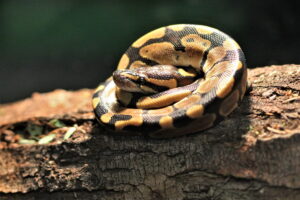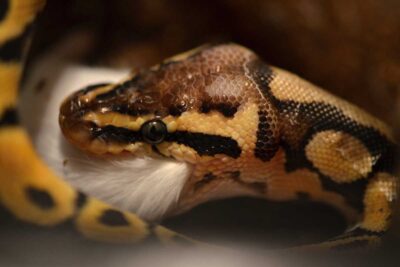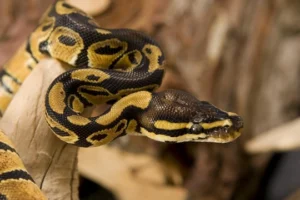Ball pythons are fascinating creatures that captivate reptile enthusiasts with their docile nature and striking appearance. If you’re considering welcoming one of these serpentine companions into your home, one of the first questions you might have is: How often should I feed my ball python?
You should feed your ball python every 5-7 days as a general guideline. It’s essential to monitor your ball python’s body condition and adjust the feeding schedule accordingly. If your snake appears overweight or underweight, you may need to adjust the frequency and portion size of their meals.
Additionally, always ensure that you’re offering appropriately sized prey items that are no larger than the widest part of your snake’s body. Remember, individual ball pythons may have slightly different feeding needs, so pay attention to your snake’s behavior and appetite cues.
How often do you feed a ball python?

Ball pythons are typically fed once every 1-2 weeks, depending on their age, size, and individual metabolism. Here’s an explanation of why this feeding schedule is recommended:
- Metabolic Rate: Ball pythons have a relatively slow metabolism compared to other snake species. They are ambush predators in the wild, which means they consume relatively large meals at infrequent intervals. This slow metabolic rate allows them to efficiently digest their food over a longer period.
- Growth Rate: Young ball pythons grow more rapidly than adults, so they require more frequent feedings. Juvenile ball pythons (under a year old) may be fed every 5-7 days, while adults can be fed every 10-14 days. Once they reach adulthood, their growth slows down, and they can be transitioned to a less frequent feeding schedule.
- Digestive Health: Feeding too often can lead to regurgitation or digestive issues in ball pythons. Their digestive systems need time to fully process and metabolize their meals. Feeding on a regular schedule helps maintain their digestive health.
- Weight Management: Regularly monitoring the snake’s weight is essential. If a snake is underweight, feeding may need to be more frequent, while overweight snakes may require less frequent feedings or smaller meals.
- Behavioral Considerations: Ball pythons may fast for periods, especially during breeding season, shedding, or when they feel stressed. Offering food too frequently during these times can lead to refusal and wasted food.
- Health and Longevity: Overfeeding can lead to obesity and related health problems in ball pythons. Following a proper feeding schedule helps maintain their health and longevity.
Overall, the feeding frequency for ball pythons strikes a balance between providing them with adequate nutrition and ensuring their digestive health and overall well-being.
Adjustments to the feeding schedule may be necessary based on individual factors such as age, size, and health status. Regular monitoring and observation of the snake’s behavior and body condition are crucial for determining the appropriate feeding schedule.
Understanding Ball Python Dietary Needs
Understanding the dietary needs of ball pythons is crucial for their health and well-being. Here’s a comprehensive look at what ball pythons eat and how to meet their nutritional requirements:
- Prey Items: In the wild, ball pythons primarily feed on small mammals such as mice and rats. They are constrictors, meaning they subdue their prey by wrapping around it and squeezing until it suffocates. In captivity, they can be fed pre-killed or frozen-thawed rodents, which are safer and more convenient than live prey.
- Size of Prey: The size of the prey should be appropriate for the snake’s size and age. Hatchling and juvenile ball pythons should be fed smaller prey items, such as appropriately-sized mice, while adult ball pythons can consume larger prey, such as adult mice or rats.
- Feeding Schedule: As mentioned earlier, ball pythons should be fed once every 1-2 weeks, depending on their age, size, and metabolic rate. Younger snakes may require more frequent feedings, while adults can be fed less often.
- Nutritional Balance: It’s essential to ensure that the prey items fed to ball pythons are nutritionally balanced. Rodents should be properly supplemented with vitamins and minerals to prevent nutritional deficiencies. Additionally, offering a variety of prey items, such as mice and rats, can help provide a more balanced diet.
- Avoid Overfeeding: Overfeeding can lead to obesity and related health issues in ball pythons. It’s important to monitor the snake’s body condition and adjust the feeding schedule accordingly. A healthy ball python should have a slightly rounded body without prominent ribs or spine.
- Hydration: While ball pythons obtain most of their water from their prey, providing access to a clean water bowl is essential for hydration. Snakes may soak in their water bowl or drink directly from it, especially before shedding.
- Supplementation: Some keepers choose to dust prey items with calcium and vitamin supplements before feeding to ensure their snake’s nutritional needs are met. However, supplementation should be done sparingly and as recommended by a reptile veterinarian to avoid over-supplementation.
Understanding and meeting the dietary needs of ball pythons is vital for their health, growth, and overall well-being. Consulting with a reptile veterinarian or experienced reptile keeper can provide further guidance on proper nutrition and feeding practices for ball pythons.
Factors Affecting Ball Python Feeding Frequency
Several factors influence the feeding frequency of ball pythons. Understanding these factors is crucial for providing optimal care and maintaining the health of your snake. Here are some key factors that affect feeding frequency:
- Age: Young ball pythons grow more rapidly than adults and have higher energy requirements. As a result, they typically require more frequent feedings. Hatchlings and juvenile ball pythons may need to be fed every 5-7 days, while adults can be fed less frequently, typically every 10-14 days.
- Size: The size of the snake directly impacts its feeding frequency. Larger snakes require larger prey items, which take longer to digest. Therefore, they can be fed less frequently compared to smaller snakes.
- Metabolism: Each snake has its own metabolic rate, which can vary based on factors such as genetics, activity level, and environmental conditions. Some ball pythons may have faster metabolisms and require more frequent feedings, while others may have slower metabolisms and can be fed less often.
- Health: The health and condition of the snake play a significant role in determining its feeding frequency. Snakes that are recovering from illness or injury may have different feeding requirements than healthy snakes. Additionally, obese or underweight snakes may require adjustments to their feeding schedule to achieve a healthy body condition.
- Seasonal Changes: Ball pythons may exhibit changes in feeding behavior in response to seasonal variations in temperature and daylight. They may go off feed during the breeding season or reduce their food intake during the cooler months of the year.
- Reproductive Status: Female ball pythons may fast or reduce their food intake during the breeding season and pregnancy. This natural behavior helps conserve energy for reproduction. Male ball pythons may also exhibit changes in feeding behavior during the breeding season.
- Activity Level: Snakes that are more active may have higher energy requirements and therefore require more frequent feedings. Conversely, snakes that are less active may require fewer feedings.
- Individual Preference: Some ball pythons may have preferences for certain types or sizes of prey items, which can influence their feeding frequency. Offering a variety of prey items can help encourage feeding in picky eaters.
By considering these factors and closely monitoring your ball python’s behavior and body condition, you can determine the appropriate feeding frequency to meet its nutritional needs and ensure its overall health and well-being.
Feeding Schedule for Ball Pythons
Establishing a proper feeding schedule is essential for the health and well-being of ball pythons. Here’s a general guideline for a feeding schedule based on the age and size of the snake:
- Hatchlings (0-6 months):
- Offer appropriately sized prey every 5-7 days.
- Start with pinky mice or rat pups and gradually increase the size of the prey as the snake grows.
- Juveniles (6 months – 1 year):
- Feed every 7-10 days with appropriately sized prey.
- As the snake continues to grow, gradually increase the size of the prey items.
- Subadults (1 – 2 years):
- Feed every 10-14 days with appropriately sized prey.
- By this stage, the snake should be eating small rats or mice, depending on its size.
- Adults (2+ years):
- Feed every 10-14 days with appropriately sized prey.
- Adult ball pythons can consume larger prey items such as medium to large rats.
It’s important to adjust the feeding schedule based on individual factors such as the snake’s metabolism, activity level, and overall health. Here are some additional tips for maintaining a healthy feeding schedule:
- Monitor Body Condition: Regularly assess the snake’s body condition to ensure it’s neither underweight nor overweight. A healthy ball python should have a slightly rounded body without visible ribs or spine.
- Observe Feeding Response: Pay attention to the snake’s feeding response. If it eagerly strikes and consumes its prey, it’s likely hungry and ready to eat. However, if it consistently refuses food, it may be stressed, in shed, or experiencing other health issues.
- Offer Variety: Provide a variety of prey items to ensure nutritional balance and prevent dietary deficiencies. This can include mice, rats, and occasionally chicks or other small vertebrates.
- Hydration: While ball pythons obtain most of their water from their prey, always ensure they have access to a clean water bowl. Proper hydration is essential for digestion and overall health.
- Seasonal Adjustments: Ball pythons may exhibit changes in feeding behavior in response to seasonal variations in temperature and daylight. Adjust the feeding schedule accordingly, especially during the breeding season.
By following these guidelines and closely monitoring your ball python’s feeding response and body condition, you can establish a feeding schedule that promotes optimal health and growth.


